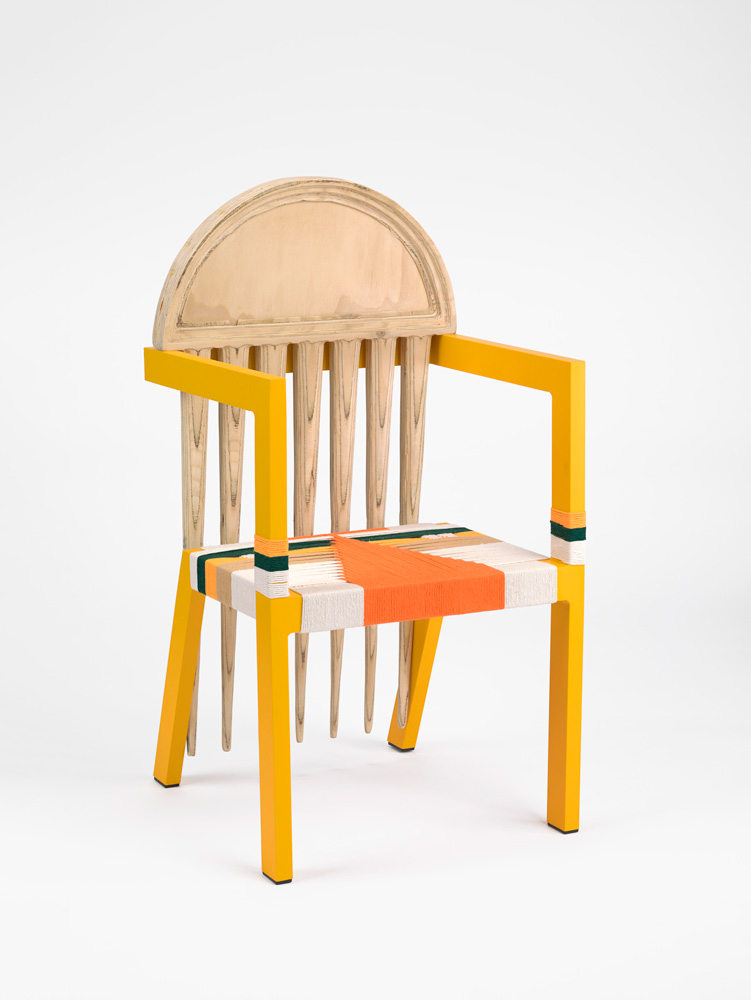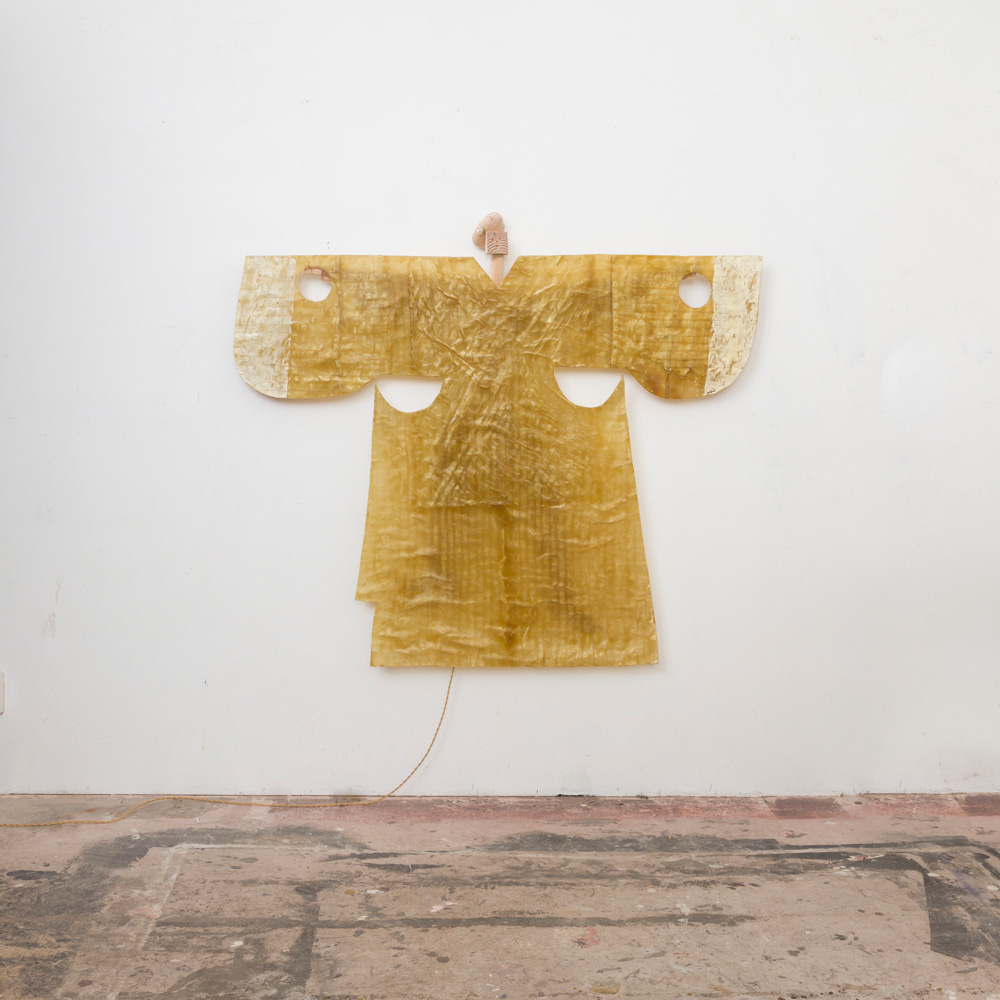
Cheick Diallo, M’be yan II (I’m Here), 2018. Reclaimed steel; 32 × 25 × 45 in. Denver Art Museum: Funds from the Architecture and Design Collectors’ Council with additional support from Nancy Leprino, 2023.79. © Cheick Diallo
Cheick Diallo
M’be yan II (I’m Here), 2018
Malian designer Cheick Diallo’s M’be yan II (I’m Here) is made of salvaged steel—a scrap material easy to source in Mali. The metal rectangles, which vary in size and color, are arranged in a patchwork that calls attention to the material’s reclaimed nature. M’be yan II exemplifies the range of furniture that Diallo and his team of artisans produce in Mali’s bustling capital of Bamako. The studio employs locally sourced and occasionally salvaged materials such as scrap metal and fishing wire, remnants of industrial processes. However, Diallo’s main concern is not economy; rather he is on a kind of archaeological quest for locally available materials and their special properties for which he finds novel applications in his designs. “I don’t have an interest in design if it is only to remake that which already exists,” he has declared.

Germane Barnes, Uneasy Lies the Head That Wears a Crown (12), 2020. Metal, rope, wood, and putty; 42 × 20 × 21 in. Denver Art Museum: Funds from the Architecture and Design Collectors’ Council with additional support from Nancy Leprino, 2023.209. © Germane David Barnes
Germane Barnes
Uneasy Lies the Head That Wears a Crown (12), 2020
Miami-based American architect Germane Barnes’s Uneasy Lies the Head That Wears a Crown is fabricated from metal, wood, and rope. The chair’s materials mimic the wood structures and metal roofs of shotgun houses in South Florida. Prevalent in African American communities throughout the southern United States, shotgun homes reflect African, Caribbean, and colonial influences. They are often built with gabled front porches, which have played an integral role in African American life. One of the most important features of these porches, according to Barnes, are the ubiquitous porch chairs.
The chair’s seat evokes the braiding techniques often found in Black hairstyles, while its back is inspired by the crowns worn by Black people across the diaspora, from Sunday Service hats to the legendary afro pick. This acquisition corresponds to concepts presented in the museum’s arts of Africa gallery and provides grounds for cross-collection collaboration at the museum.

Chris Wolston, Hand Chandelier, 2021. Wicker, metal, and electrical components; 50 dia. in. Denver Art Museum: Funds from the Architecture and Design Collectors’ Council with additional support from Nancy Leprino, 2023.497. © Chris Wolston. Photograph by David Sierra, courtesy of the artist and The Future Perfect.
Chris Wolston
Hand Chandelier, 2021
Chris Wolston is an American artist and designer based in Brooklyn, New York and Medellín, Colombia. Wolston’s work, from furniture and lighting to installation and sculpture, blends time-honored South American craftsmanship with an irreverent postmodern twist to create objects that delight and confound. After first studying artmaking traditions in Ghana, Wolston received a Fulbright grant to research different modes of production, in particular traditional ceramics and brickmaking, in Colombia—a move that strongly influenced his artistic trajectory. Invigorated by his experiences in Colombia, Wolston opened a second studio in Medellín to continue collaborating with local foundries, workshops, and fabricators.
Wolston’s wonderfully playful chairs, lighting, and other furniture pieces are woven from an ethically sourced Colombian wicker called mimbre. The Hand Chandelier depicts a myriad of hands holding light bulbs. The anthropomorphic forms and silhouettes of his functional work convey a sense of familiarity while reframing our perspective of the joyful possibilities of furniture.

Hamed Ouattara, Indigola Cabinet, 2014. Reclaimed oil drums; 48 × 34 × 12 in. Denver Art Museum: Funds from the Architecture and Design Collectors’ Council with additional support from Nancy Leprino, 2023.204. © 2022 Studio Hamed Ouattara, All rights reserved.
Hamed Ouattara
Indigola Cabinet, 2014
Burkinabé artist and furniture designer Hamed Ouattara is relentlessly creative despite the shortage of tools and the frequency of power outages in his home country of Burkina Faso. Working with a team of local artisans in the country’s capitol Ouagadougou, Ouattara supervises the transformation of discarded oil barrels into functional cabinets, chairs, and tables. Each piece, with its worn patina, draws attention to its former life and the stories contained within it—a story of the supposed disposability of the world’s resources and of global excessive consumption.
Ouattara launched Studio Hamed Ouattara to share his know-how and metalworking techniques. The shop is also a classroom, where Ouattara imparts his lessons of authenticity to young apprentices. A dozen local artisans now work with Ouattara full time. Ouattara’s goal is to influence, in the long term, design development and economic inequality through the creation of jobs in Burkina Faso.

Minjae Kim, Garb 4, 2023. Quilted fiberglass, resin, wood, pearl, brass and a few screws; 64 × 55 × 4-1/2 in. Denver Art Museum: Funds from Textile and Fashion Circle, the Arts of Asia Department Acquisitions Fund, and the Architecture and Design Collectors' Council with additional support from Nancy Leprino, 2023.403 © Minjae Kim. Photography by Luis Corzo, courtesy of Nina Johnson Gallery.
Minjae Kim
Garb 4, 2023
Drawing from a background in architecture and design, Korean-born and Brooklyn-based artist and designer Minjae Kim branched into developing his own artistic practice during the pandemic. Kim’s intentional choices of familiar materials and mediums fuse together to create one-of-a-kind pieces, such as this light fixture in the form of a traditional Korean robe, made from fiberglass and resin.
This light fixture is from a body of work titled IYKYK (If You’re Korean, You Know), where Kim plays with explicit references of traditional Korean aesthetics to emphasize the societal impact of our dominantly Westernized world. To a Western eye these references read as abstract art, but to individuals of Korean heritage, they appear clear and immediate.

